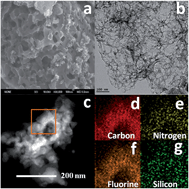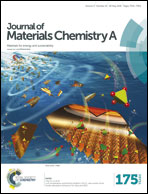Si–C–F decorated porous carbon materials: A new class of electrocatalysts for the oxygen reduction reaction†
Abstract
The development of efficient oxygen reduction reaction (ORR) electrocatalysts composed of low cost and earth abundant elements is imperative for several energy systems. It has been reported that metal-free co-doped materials play a key role in the oxygen reduction reactions. However, a Si/F co-doped material has never been considered as an electrocatalyst for the ORR. Herein, we report a Si–C–F decorated three-dimensional porous carbon material by a facile pyrolysis of a mixture of D-glucose, ammonium fluoride and SiO2 nanoparticles in an argon atmosphere. It shows an excellent electrocatalytic performance with an onset potential of E = 0.24 V and a limiting current density of I = 4.5 mA cm−2 which is better than that of traditional electrocatalysts under neutral conditions. This outstanding electrocatalytic performance is due to the synergistic effect of silicon and fluorine which causes a change in the charge distribution and energetic characteristics of the Si–C–F decorated porous carbon material. For the practical application, a microbial fuel cell equipped with this electrocatalyst as the cathode reveals a high maximum power output and open circuit voltage (1026 mW m−2 and 780 mV), which are higher than those of commercial 20% Pt/C catalysts (913 mW m−2 and 750 mV).


 Please wait while we load your content...
Please wait while we load your content...